Overview
- The cryptocurrency private wealth management industry is transitioning from a "people + bank" closed relationship banking model to an "open digital ecosystem." Driven by the growth of global private wealth and high-net-worth individuals, the concentration of leading firms and online services is increasing simultaneously, with the Asia-Pacific region leading in growth.
- North America and Europe are mature and stable, while Asia-Pacific is experiencing high growth, and the Middle East and Latin America are primarily focused on family offices. The demands of high-net-worth and ultra-high-net-worth individuals are shifting from "pure returns" to "safety, privacy, sustainability, and cross-border compliance," with service models diversifying into a new paradigm that combines offline advisors and data-driven algorithms.
- Asset classes are expanding to include cryptocurrencies, stablecoins, DeFi, NFTs, and RWA, leveraging "on-chain transparency + programmability" to achieve custody, advisory, yield generation, strategy execution, and on-chain governance. The core values are safety and transparency, diversified returns, privacy, and efficient cross-border operations.
- The industry currently faces new challenges related to custody and smart contract security, regulatory uncertainty, and tax compliance (with frameworks like MiCA, FATF, SFC, MAS promoting standardization).
- By October 2025, the total market capitalization of cryptocurrencies is expected to be around $3.7 trillion, with approximately 600 million users; the segmented crypto PWM AUM is estimated to be around $25-40 billion, with an annual growth rate of over 50%. Switzerland, Singapore, the UAE, and Hong Kong are becoming major hubs, gradually forming regulatory, technological, and service standards.
- Crypto PWM products are categorized from the bottom up: basic custody (cold/multi-signature/MPC) → yield management (staking, liquidity mining, yield aggregation) → structured (neutral strategies, stablecoin yields, RWA) → family governance (on-chain trusts, inheritance, privacy, and tax).
- Key risks include regulatory compliance, technology and private key security, contract safety, market volatility, and liquidity; at the same time, institutionalization and a hybrid architecture of CeFi + DeFi, RWA on-chain, and AI-driven investment advisory will become the main focus.
- As regulations become clearer, trust among high-net-worth clients will increase, and licensed institutions will become core players. In a neutral scenario, the crypto private wealth management market is expected to reach approximately $120 billion by 2028, and in an optimistic scenario, it could grow to $200-320 billion.
1. Industry Background and Trends
1.1 Overview of the Private Wealth Management Industry
Private Wealth Management (PWM) is a professional system that provides comprehensive wealth planning, investment advisory, asset allocation, tax, and inheritance services for high-net-worth individuals. The industry originated from the tradition of European private banking and has developed over a century to become one of the most stable high-end services in the global financial system. The core goal of PWM is to help clients preserve and grow their assets over the long term while balancing risk management, tax compliance, and wealth transfer needs.
Traditional PWM centers around "people + banks," emphasizing trust relationships and customized solutions. However, in the past decade, changes in wealth structure and the integration of financial technology have driven a paradigm shift in the industry. On one hand, the global wealth growth rate has accelerated, and the number of high-net-worth individuals continues to rise; on the other hand, information transparency and the rise of digital assets have changed clients' investment behaviors and risk preferences. The PWM industry is experiencing an evolution from "closed relationship banking" to an "open digital ecosystem."
1.2 Global Wealth Management Market Size Trends
According to the Boston Consulting Group (BCG) "Global Wealth Report 2025," as of March 2025, the total global private wealth has reached $255 trillion, with approximately 40% held by high-net-worth individuals (HNWI). It is expected that by 2030, the global private wealth size will grow at a compound annual growth rate (CAGR) of 5%, reaching about $330 trillion. The regional distribution of wealth growth shows a significant shift in focus: the Asia-Pacific region's wealth growth rate (7%) is significantly higher than that of the North American and European markets (3-4%).

In terms of asset allocation structure, traditional assets still dominate, with stocks, bonds, and real estate accounting for about 80%. However, the importance of alternative investments is rising, covering categories such as private equity, hedge funds, infrastructure investments, and digital assets. High-net-worth investors are beginning to pursue more liquid and innovative allocation models to achieve excess returns and risk diversification.
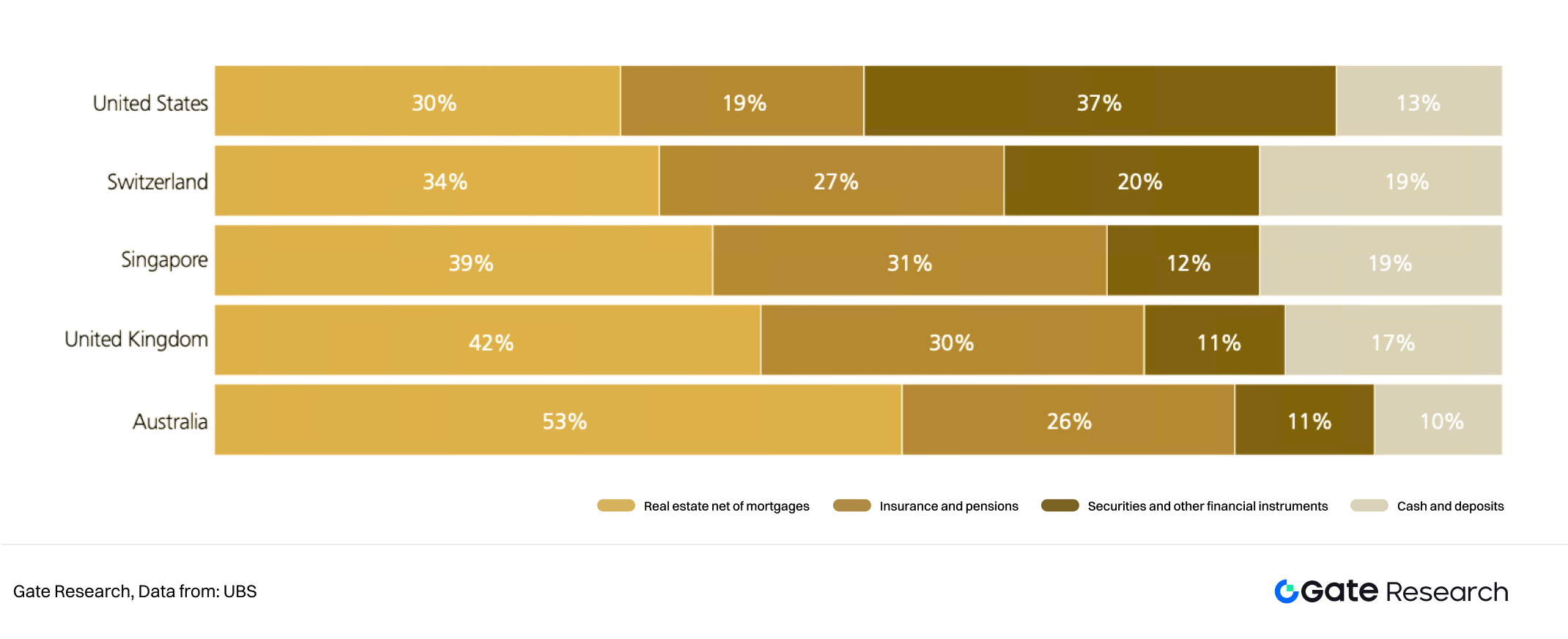
The institutional concentration in the global wealth management market is also increasing. The top ten global private banks hold over 50% of the market share. At the same time, the penetration of digital PWM services is continuously increasing, with online account opening, robo-advisors, and mobile asset monitoring gradually becoming standard features.
1.3 Global Wealth Management Market Structure
Currently, the global wealth management market can be divided into three main segments based on geographic location:
- North America and Europe: The market is mature, with complete regulations and a developed private banking system. Traditional institutions such as UBS, Morgan Stanley, and Citi Private Bank have large client bases and well-established trust systems.
- Asia-Pacific: Emerging markets are growing rapidly. China, India, Singapore, and Hong Kong have become regional centers with high levels of wealth digitization, and fintech companies are accelerating their entry into the PWM field.
- Middle East and Latin America: Wealth is highly concentrated in family or national funds. Family offices have become the primary form of wealth management, combining investment and governance functions.
Future competition will focus on how to integrate digital technology, cross-border compliance, and multi-asset service capabilities to meet the diverse needs of global clients.
1.4 Evolution of High-Net-Worth Individuals' Demands
Morgan Stanley's research indicates that the wealth management needs of high-net-worth clients are shifting from "return-oriented" to "safety, privacy, and sustainability-oriented." Traditional clients focus on long-term stable returns and trust inheritance, while the new generation of wealthy individuals (especially digital natives) emphasizes flexibility, self-management, and on-chain transparency.
This generational difference has led to a divergence in service models among PWM institutions: some institutions still adhere to offline advisor relationships, while others are shifting towards data-driven and algorithm-based digital wealth management. Clients are no longer satisfied with "passive investment portfolios" but wish to participate in strategy formulation and on-chain asset operations.
Additionally, the demand for cross-border allocation has significantly increased. With the reduction of barriers to capital flow, the trend of global asset integration is evident, and tax planning and identity compliance have become new pain points. Clients prefer to choose institutions that can provide integrated compliance services across different jurisdictions.
1.5 Private Wealth Management in the Era of Digital Assets
The development of blockchain and digital assets has brought structural changes to the PWM industry. Asset classes have expanded to include cryptocurrencies, stablecoins, DeFi protocols, NFTs, and real-world assets (RWA), extending wealth management from the traditional financial system to the on-chain economy.
The main advantages of digital assets lie in transparency and programmability. All transactions and asset flows can be verified on-chain, reducing intermediary costs and trust costs. At the same time, the trend of combining DeFi and CeFi has also redefined the boundaries of wealth management services: expanding from custody and advisory to yield generation, strategy execution, and on-chain governance.
However, digital asset PWM also faces prominent challenges, including custody security, smart contract risks, regulatory uncertainty, and tax transparency requirements. Regulatory agencies in various countries are promoting industry standardization through frameworks such as MiCA (EU), FATF (International), SFC (Hong Kong), and MAS (Singapore), providing a foundational institutional guarantee for compliant wealth management.
2. Definition and Standards of Crypto Private Wealth Management
2.1 Definition
Crypto Private Wealth Management (Crypto PWM) refers to a comprehensive service system that focuses on digital assets as the core management object, based on blockchain infrastructure, providing high-net-worth clients with asset custody, allocation, risk management, yield optimization, tax planning, and privacy protection. Unlike traditional PWM, Crypto PWM combines "financial expertise" with "on-chain technical capabilities," requiring an understanding of macro-financial logic as well as mastery of smart contracts, crypto security, and compliance regulations.
The core features of Crypto PWM include three aspects: first, the asset form is entirely digital; second, all transactions and reports can be verified on-chain; third, clients retain ultimate sovereignty over their assets. It represents a structural migration from a centralized banking system to a trustless financial network.
2.2 Differences from Traditional PWM
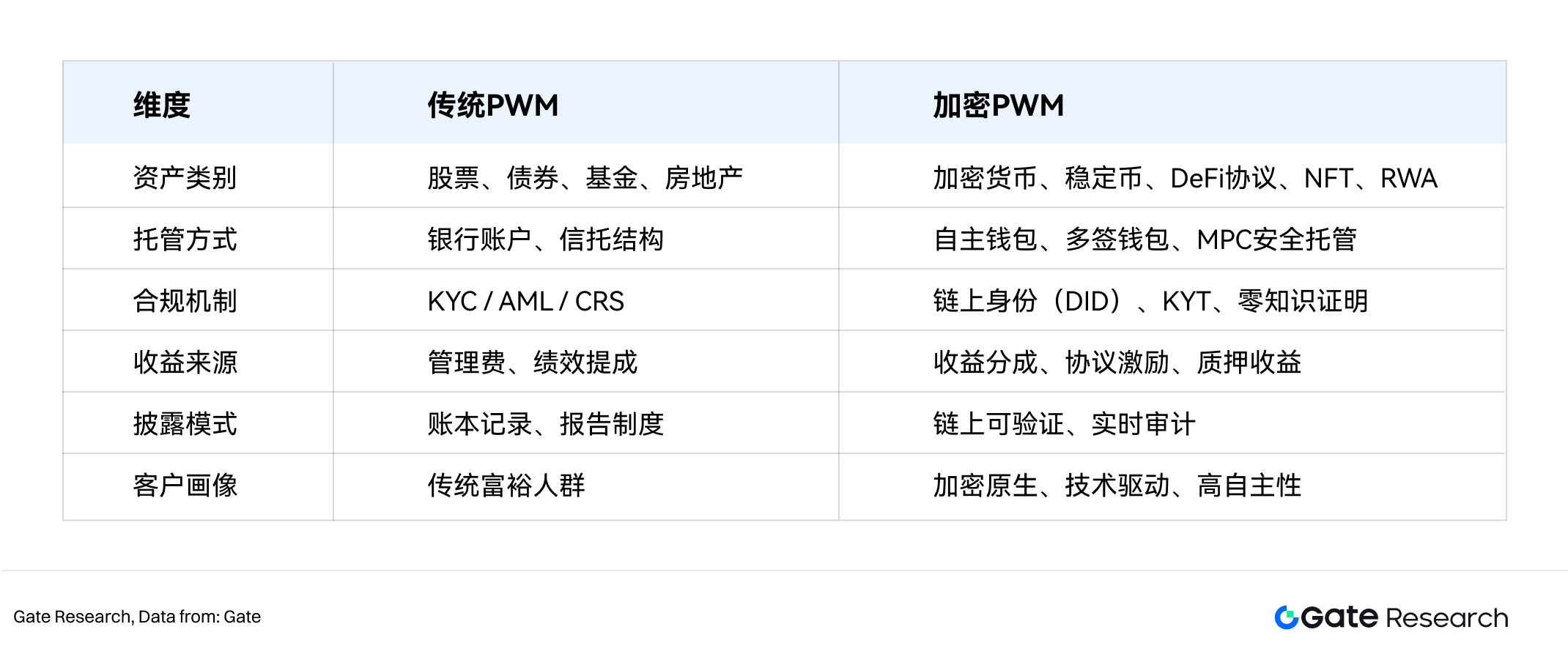
It can be seen that Crypto PWM is more like a "de-intermediated wealth management infrastructure," building a transparent and automated trust mechanism through smart contracts and on-chain identity systems.
2.3 Core Values
The core values of Crypto PWM are primarily reflected in four dimensions:
1. Security and Transparency: On-chain records ensure that asset ownership and transaction paths are traceable, preventing information asymmetry.
2. Diversified Returns: Achieving compound returns through DeFi protocols, staking, and RWA channels.
3. Sovereignty and Privacy Protection: Clients have control over their assets, with privacy ensured through encryption and zero-knowledge technology.
4. Cross-Border Liquidity and High Efficiency: 24/7 uninterrupted settlement, reducing cross-border transfer and foreign exchange costs.
2.4 Global Crypto Market Size
As of October 2025, the total market capitalization of global crypto assets is approximately $3.7 trillion, with around 600 million global crypto users, of which nearly 45% are in Asia. The total value locked (TVL) in the DeFi ecosystem is about $120 billion, primarily concentrated in mainstream networks such as Ethereum, Arbitrum, and Solana. The market capitalization of stablecoins is approximately $160 billion, becoming the core medium for crypto fund flows. Digital assets have gradually evolved from speculative investment tools to institutional allocation assets, with more banks, family offices, and hedge funds beginning to engage in crypto asset management.
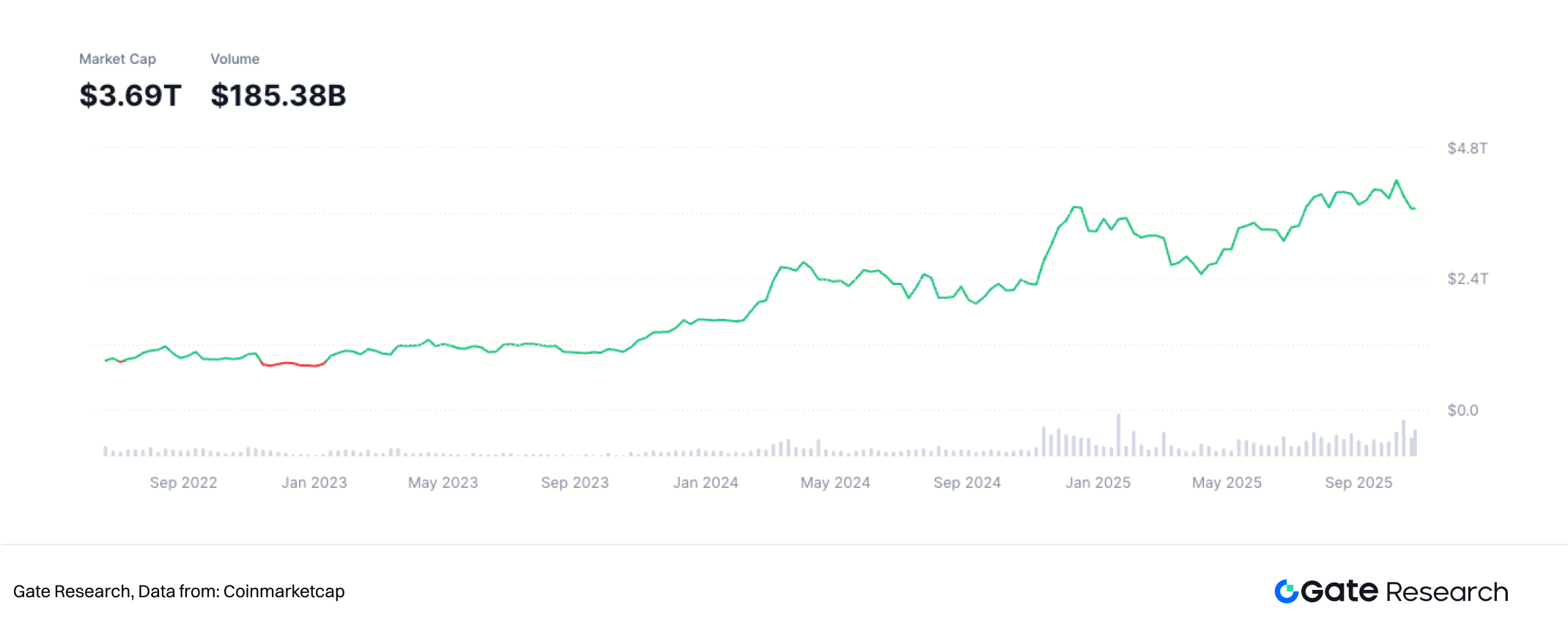
2.5 Crypto PWM Market Size
Currently, crypto PWM is still in its early stages. According to estimates from Messari and Galaxy Research, the global crypto PWM assets under management (AUM) are approximately between $25 billion and $40 billion, with an annual growth rate exceeding 50%. The main markets are concentrated in Switzerland, Singapore, the UAE, and Hong Kong, which have relatively friendly regulatory and tax environments.
Key participants include:
- Crypto Family Offices: Such as Sygnum and Zerocap, which provide on-chain trust and family management services;
- Institutional custody and banking platforms: Such as Anchorage and Coinbase Institutional;
- DeFi wealth management protocols: Such as Yearn, Enzyme, and Sommelier, which offer automated yield strategies.
It is expected that by 2030, the crypto PWM market AUM will exceed $100 billion, becoming an important component of global PWM.
3. Service Architecture
3.1 User Segmentation and Profiles
The traditional PWM industry typically categorizes users based on their asset size, dividing them into high-net-worth individuals (HNWI), ultra-high-net-worth individuals (UHNW), and family offices. This article categorizes crypto PWM clients based on the same criteria.

The client profile of crypto PWM exhibits characteristics of "high professionalism and high engagement." Crypto HNWIs tend to participate actively in asset allocation and have high demands for tools and interface experiences; UHNW clients focus more on risk control and cross-border compliance; institutional clients prioritize transparency, audit standards, and tax structure design.
Compared to traditional PWM, crypto PWM clients are younger, more technology-oriented, and possess higher digital financial literacy. Their needs are no longer limited to "trusting advisors" but lean more towards "verifiable systems."
3.2 Product Spectrum
The product system of crypto PWM structurally resembles that of traditional private wealth management, moving from "custody and preservation" to "investment and yield" and then to "inheritance and governance." However, due to differences in underlying assets, technological architecture, and sources of yield, crypto PWM shows significant differences in product composition and risk management approaches.
Typically, the product system of PWM can be divided into four categories:
1. Basic Custody: Including cold wallet custody, multi-signature accounts, and MPC security custody solutions.
2. Yield Management: Including staking, DeFi liquidity mining, and automated yield aggregation.
3. Structured Investment: Including neutral strategy portfolios, stablecoin yield funds, and RWA asset channels.
4. Comprehensive Family Services: Including on-chain trusts, estate inheritance, privacy identity management, and tax consulting.
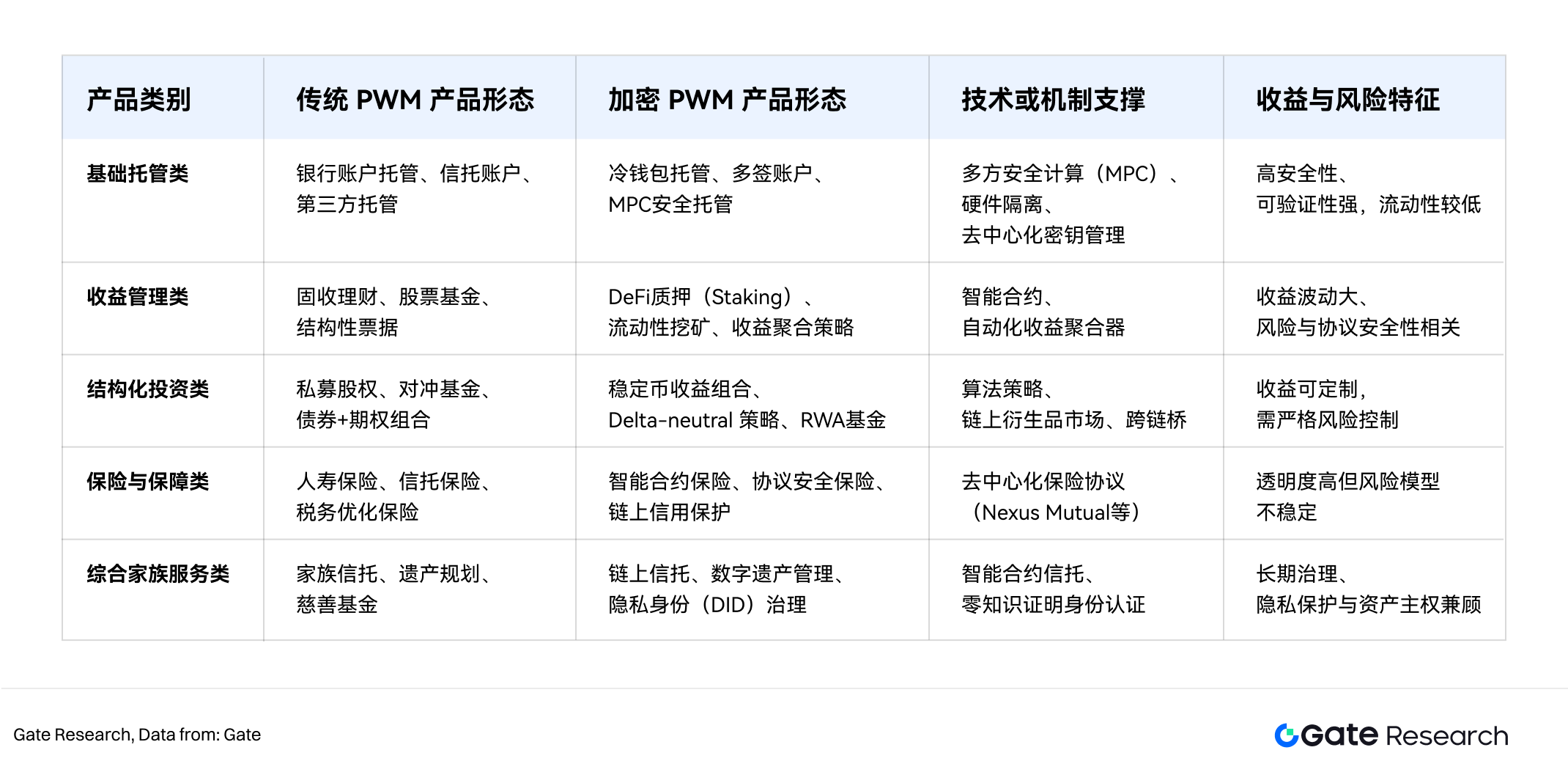
It can be seen that crypto PWM has achieved a transition from a closed trust structure to a verifiable open protocol system at the product level. Traditional PWM relies on the legal trust and human advisory systems of financial institutions, while crypto PWM builds service boundaries through cryptographic trust and code execution logic.
One significant change brought about by this structure is that the product innovation cycle of crypto PWM is shorter, with new strategies (such as Restaking yield portfolios and cross-chain RWA funds) able to iterate and launch quickly; at the same time, the speed of risk transmission is also faster, requiring PWM institutions to have on-chain risk monitoring and protocol due diligence capabilities.
Additionally, from the perspective of customer experience, the product offerings of crypto PWM are more modular and customizable. Users can choose combination plans based on their risk preferences, yield goals, and compliance identities, flexibly switching from "fully managed mode" to "self-managed mode." This flexibility makes it highly attractive to the younger high-net-worth demographic.
3.3 Service Process
A typical crypto PWM process includes five stages: client identification and due diligence (KYC/KYT), asset assessment and allocation recommendations, execution and custody, performance tracking and auditing, and compliance and tax optimization. After clients complete registration and verification through the on-chain identity system, the advisory team formulates allocation plans based on on-chain data and risk preferences. The execution and custody phases rely on smart contracts and MPC technology to achieve automated execution and security assurance, with all operations verifiable on-chain. Performance reports and risk monitoring are generated using real-time data to ensure transparency and auditability.
3.4 Value-Added Services
Crypto PWM institutions typically offer a range of value-added services, including education and research reports, market insights and trend analysis, cross-border tax and legal consulting, privacy identity management, and on-chain trust structure design. These value-added modules help clients achieve full-cycle management from asset allocation to inheritance governance, further enhancing client stickiness and service depth.
4. Product Cases
Below, we will take Morgan Stanley as an example to outline the service architecture and investment strategies of traditional private wealth management; at the same time, we will analyze the characteristics of crypto wealth management in terms of yield models, strategy iteration, and client customization using Gate's private wealth management business as a case study, thereby comparing the core differences and practical experiences of the two types of institutions.
4.1 Traditional Private Wealth Management Institution: Morgan Stanley
Traditional wealth management institutions typically focus on high-net-worth clients (assets > $5 million) and develop comprehensive asset allocation plans based on client needs. The world's top 10 wealth management institutions (by AUM) include Morgan Stanley, UBS, JP Morgan, Goldman Sachs, etc. Most of these institutions are top investment banks, allowing them to achieve "resource integration," enabling clients to enjoy cross-departmental resource services such as products and research capabilities.
Taking the top institution Morgan Stanley as an example, the Morgan Stanley Private Wealth Management division was established in 1977, covering portfolio management, tax optimization, insurance, and family office services. The overall wealth management business has a massive AUM, exceeding $8.2 trillion globally as of Q2 2025, accounting for 45% of the company's total revenue. The division has about 80,000 employees across 45 countries, with 350 teams dedicated to serving high-net-worth clients with net assets in the tens of millions of dollars to meet their wealth lifecycle needs.
It is worth mentioning that starting from October 15, 2025, Morgan Stanley is expanding cryptocurrency investment opportunities to all clients and allowing such investments in any type of account, including retirement accounts.
The process of wealth management planning at Morgan Stanley is primarily divided into three steps:
Client Goal Setting: This includes family goals, cash flow needs, risk tolerance, intergenerational transfer goals, tax and legal constraints, etc. This stage determines the long-term strategy and the boundaries of short- and medium-term tactics.
Financial Planning and Asset Allocation: A dual-track allocation approach is adopted, combining strategic and tactical allocations. Strategic allocations are typically reviewed annually and adjusted based on long-term capital market assumptions, while tactical allocations are updated relatively frequently (about 3-5 times a year) based on the CIO's market views. Among these, asset allocation has the most significant impact on portfolio returns, accounting for about 90% of overall returns.
Portfolio Construction, Risk, and Tax Management: Portfolios are constructed through a mixed asset allocation approach of "actively seeking excess returns + passively controlling cost risks," combined with tax optimization to enhance after-tax returns. Depending on different clients' risk preferences, five risk-tiered product lines are offered, ranging from "conservative—yield—balanced—growth—aggressive," with diverse investment directions such as stocks, fixed income, alternatives, and tax-efficient strategies to meet different risk, liquidity, and tax preferences.
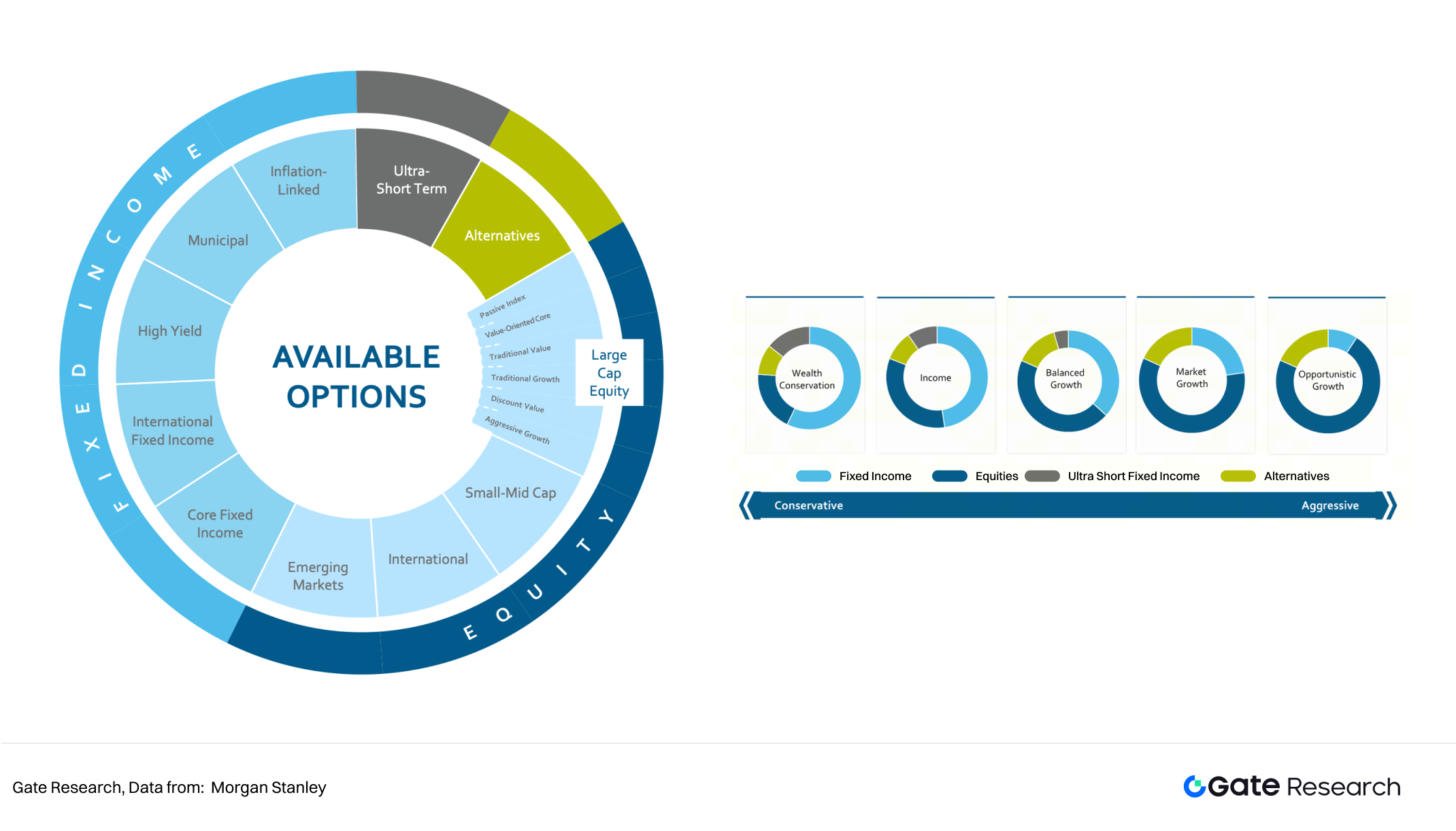
Due to the highly customized nature of PWM products, institutions typically do not publicly disclose specific investment portfolio performance data. For example, the conservative mixed asset strategy fund MRJIX issued by Morgan Stanley has a one-year return rate of 7.10%, with volatility and maximum drawdown significantly lower than the benchmark S&P 500, fully reflecting the robust value-added capability brought by diversified asset allocation.

Although specific strategies may vary among different clients, the products' returns, drawdowns, and strategies typically exhibit the following common characteristics:
Targeting high-net-worth clients: High-end wealth management products usually have minimum investment amounts ranging from hundreds of thousands to millions of dollars. Some structured or private equity products require higher thresholds to ensure that investors have sufficient risk tolerance and long-term capital stability.
Diversification as the core principle of the portfolio: Covering asset classes such as stocks, bonds, money market instruments, hedge funds, private equity, real estate, and commodities. Portfolios are typically constructed using a core-satellite approach, with the core portion leaning towards stable returns and defensive allocations (such as high-quality bonds, blue-chip stocks, cash, etc.), while the satellite portion is used to capture growth and excess return opportunities (such as emerging markets, tech stocks, PE/VC, or thematic funds).
Prioritizing volatility control and drawdown defense: To protect client capital safety, PWM products typically set lower leverage, and during significant market downturns, the maximum drawdown of the overall asset portfolio is usually controlled within 10-15%. In some portfolios where capital preservation is the primary goal, drawdowns may be below 10%.
Steady but not extreme returns: The annual target return rate for wealth management institutions' products is approximately in the range of 5-8%, with a stable allocation ratio. Generally, growth assets account for 8-32%, while defensive assets account for about 68-92%. For clients with more aggressive risk preferences, a certain proportion (about 10-30%) of alternative assets may be embedded in the portfolio to pursue excess returns.
Emphasizing tax, trust, and family governance: For example, using trust structures and family trusts to reduce estate tax burdens and legal disputes, while optimizing tax efficiency through tax-advantaged accounts, making wealth management have a stronger "family asset lifecycle management" characteristic.
Longer product cycles: Design and adjustment cycles are often measured in years or quarters to avoid chasing highs and lows, with strategic adjustments made only when policies or valuations change significantly.
4.2 Crypto Private Wealth Management Institution Case: Gate
Traditional institutions are oriented towards long-term stable growth, while crypto wealth management has formed a more dynamic and flexible yield model in a high-volatility, high-innovation market. In addition to the common "holding coins for appreciation" logic, the sources of yield in crypto private wealth management are more diverse, including staking, lending, liquidity mining, and arbitrage profits, among others.
Despite having a more technical and open operational logic, crypto wealth management institutions inherit the service system of traditional institutions, adhering to a one-stop, full-process management philosophy of "demand communication → customized solutions → product configuration → data tracking → regular reviews." This article uses Gate's private wealth management business as an example to illustrate the core objectives, product composition, and yield simulation of private wealth management for crypto assets.
Gate officially launched its exclusive private wealth management service for high-net-worth clients in September 2025, leading a new trend in the high-end digital finance sector. The service is centered around the core concepts of "personalized customization and secure compliance," specifically tailored for ultra-high-net-worth clients, aiming to provide a financial service experience and digital asset management solutions comparable to top private banks through personalized asset allocation and professional management.
Key highlights of Gate's private wealth management service include:
Top-tier Compliance and Security: Backed by Gate's global compliance framework and multiple security measures, a top-notch risk control system ensures the safety of digital assets, allowing for relaxed investment and peace of mind regarding wealth.
Customized Investment Solutions: Tailored asset allocation is provided based on clients' investment goals, risk preferences, and market conditions, covering a diverse product mix of mainstream assets and hot projects to achieve highly competitive investment returns.
Private Advisors and Expert Teams: A team composed of private advisors and professional quantitative experts, including client managers, investment advisors, wealth planning consultants, and daily service personnel, provides one-to-one private banking-level services to clients.
Exclusive Research and Analysis Support: The Gate platform integrates big data and AI technologies, with a professional quantitative team providing each ultra-high-net-worth client with exclusive industry research reports and strategy optimization suggestions to support client decision-making.
Gate will design personalized asset allocation plans based on clients' liquidity needs and future plans, covering cryptocurrencies, private equity funds, NFTs, bonds, and stable yield products. Additionally, exclusive value-added services such as priority subscription rights in ecosystems, family trusts, and tax planning consultations are included, which are particularly important for high-net-worth clients with complex cross-border tax situations.
Private wealth clients can choose corresponding strategies based on their risk preferences, such as high-frequency market making, fee arbitrage, term arbitrage, and market maker arbitrage, among others. Furthermore, in the crypto market, clients can participate in cutting-edge projects through Gate Perp DEX, Launchpad, and Layer2 ecosystems. In traditional finance, clients can also access stable dollar notes, structured financial products, and gold hedging configurations. The dual-channel design allows the asset portfolio to have both growth potential and stable returns.
The following is an introduction to the smart arbitrage-USDT solution:
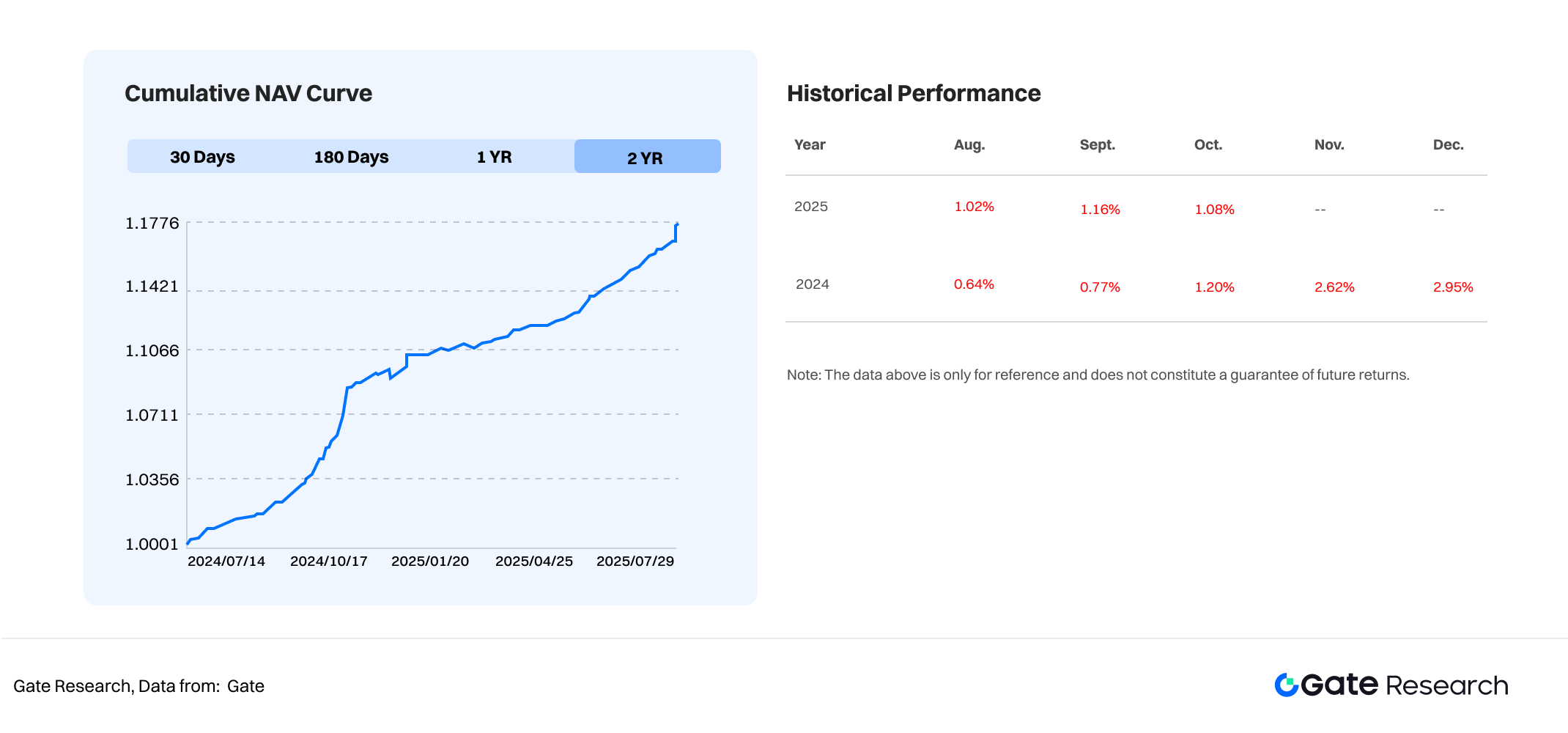
This fund adopts a neutral arbitrage strategy, primarily including the following three methods:
Cash-Futures Arbitrage: Arbitrage trading through the basis between spot and futures;
Funding Rate Arbitrage: Utilizing the price anchoring mechanism of perpetual contracts for arbitrage;
Market Maker Arbitrage: Profiting by providing liquidity to the market.
This fund is suitable for investors "seeking long-term stable returns" and "wishing to achieve diversified asset allocation," with the following core highlights:
Professional Research Team: The high volatility of the crypto market often leads to significant drawdowns or even liquidations for many individual investors during severe adjustments. However, under the management of a professional team, volatility can be minimized, maximizing Alpha returns. For example, the research personnel of Gate's fund products are PhDs and Masters from globally renowned universities, with experience in core departments of well-known trading institutions, possessing practical experience in macro research, quantitative modeling, and risk management.
Comprehensive Strategy Risk Control: This includes risk exposure management, position control, early warning and emergency mechanisms, and strategy dynamic adjustments based on real-time market feedback. In extreme market conditions, the system will prompt risk limits to prevent excessive concentration in a single asset or strategy, effectively reducing portfolio volatility and ensuring the safety of client assets.
Advanced Trading System: The team's high-performance execution engine has high-frequency trading capabilities, enabling orders to be executed at optimal prices and significantly reducing trading slippage. Additionally, through real-time data monitoring and algorithm optimization, the system can maintain stable operation even in tight liquidity or severe market fluctuations, accurately capturing short-term arbitrage and price difference opportunities.
Robust Historical Performance: Since its establishment, the team has consistently delivered stable performance. Historical data shows that the product's annualized return rate reaches 14.89%, with maximum drawdown controlled within -0.37%, far below the industry average. This achievement not only reflects the team's robust trading capabilities across different market cycles but also validates its excellent execution in strategy diversification and risk defense mechanisms.
Overall, through the case of Gate, it is evident that crypto private wealth management not only inherits the full-process, customized service philosophy of traditional wealth management but also leverages on-chain transparency, programmability, and diverse yield mechanisms to achieve dynamic asset appreciation and risk control in a high-volatility market, providing high-net-worth clients with a new paradigm of digital wealth management that combines security and globalization.
5. Summary
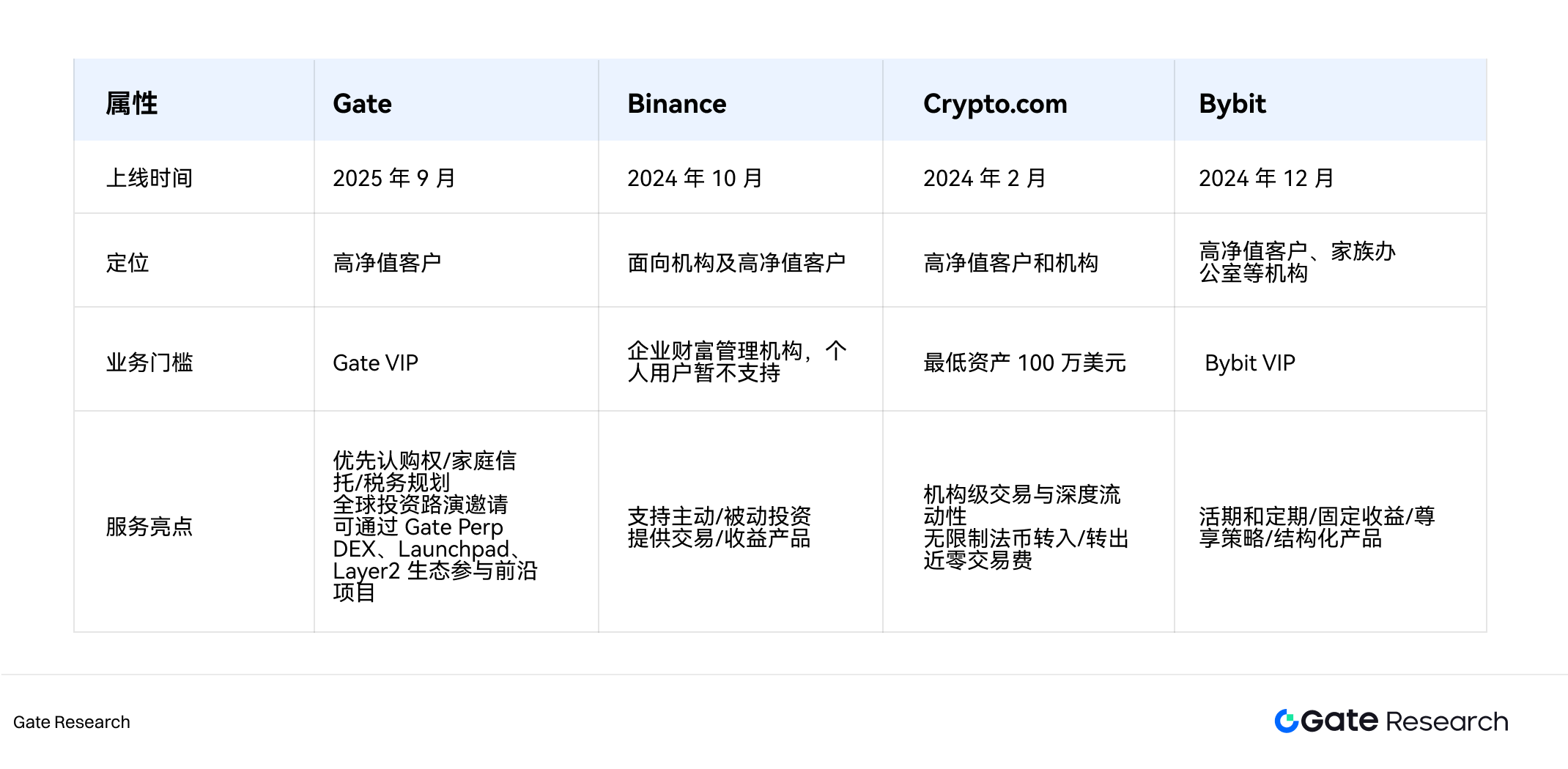
Overall, at the strategic level, traditional wealth management emphasizes "preservation + inheritance," while crypto wealth management is more flexible and innovative. Unlike traditional institutions that adjust strategies on a quarterly or annual basis, the high-frequency volatility of the crypto market requires managers to possess the ability for "rapid switching" and "dynamic rebalancing." Professional teams can adjust positions in real-time based on on-chain data, market liquidity, and macro trends, flexibly switching strategies.
5. Risks and Challenges
Private wealth management for crypto assets is currently in a stage of "transitioning from high-risk speculation to institutional management."
Its core value lies in:
Diversified Allocation: Expanding new sources of yield through crypto assets;
Transparency and Autonomy: On-chain data is verifiable;
Global Liquidity: 24/7, borderless asset allocation.
However, its long-term development is still constrained by regulatory certainty, market maturity, and risk management capabilities. As the cryptocurrency market is still in a developmental stage and highly volatile, many traditional wealth management institutions remain cautious. How to reasonably incorporate crypto assets into clients' wealth allocation systems while effectively controlling risks has become an important issue facing the industry. The following content will discuss compliance risks, technological risks, market volatility risks, and liquidity risks.
5.1 Compliance Risks
Compliance is the primary challenge faced by crypto private wealth management institutions. Although regulations and industry reports indicate an increase in compliance investment by institutions and wealth management, the attitudes of governments and regulatory bodies towards cryptocurrencies vary globally. Even in countries and regions that are open to crypto assets, their regulatory attitudes and legal frameworks differ significantly; some countries view them as securities, financial instruments, or valuable securities, while others classify them as commodities or virtual assets, making it difficult to form a unified standard.
In terms of business, if a crypto private wealth management institution provides functions such as custody, wealth management, and asset advisory services, it may need to apply for custody licenses, fund management licenses, investment advisory licenses, etc., or it may be regarded by regulatory bodies as illegal fundraising or operational behavior. Additionally, crypto private wealth management platforms may serve clients from multiple jurisdictions, and different regulatory mechanisms may conflict, requiring institutions to manage legal conflicts and compliance boundaries effectively.
These regulatory uncertainties can limit cross-border asset migration, custody choices, and the design of structured products, thereby affecting the range of marketable products and the potential returns for clients. At the same time, some regulatory changes, such as restrictions on trading or changes in custody license requirements, may also lead to short-term asset transfers or liquidity contractions, impacting client experience and compliance costs.
The uncertainty of compliance creates a high legal risk during the initial stages of wealth management operations, necessitating institutions to have forward-looking legal teams and prudent strategies. For crypto asset institutions, establishing a compliance matrix adaptable to multiple jurisdictions and switchable custody and clearing solutions, such as centralized custody or connections with qualified custodians and regulated brokers, may be the best path to address regulatory complexities.
5.2 Technological Risks
Technological risks primarily stem from the inadequacies of underlying blockchain technology and the vulnerabilities in the storage and trading of digital assets. For example, smart contract vulnerabilities, security incidents at exchanges, or improper management of private keys can lead to theft or permanent loss of client assets.
In recent years, incidents such as the DAO hack and attacks on centralized exchanges resulting in large-scale capital losses have occurred frequently. For instance, as of 2025, the amount stolen from cryptocurrency services has exceeded $2.17 billion.
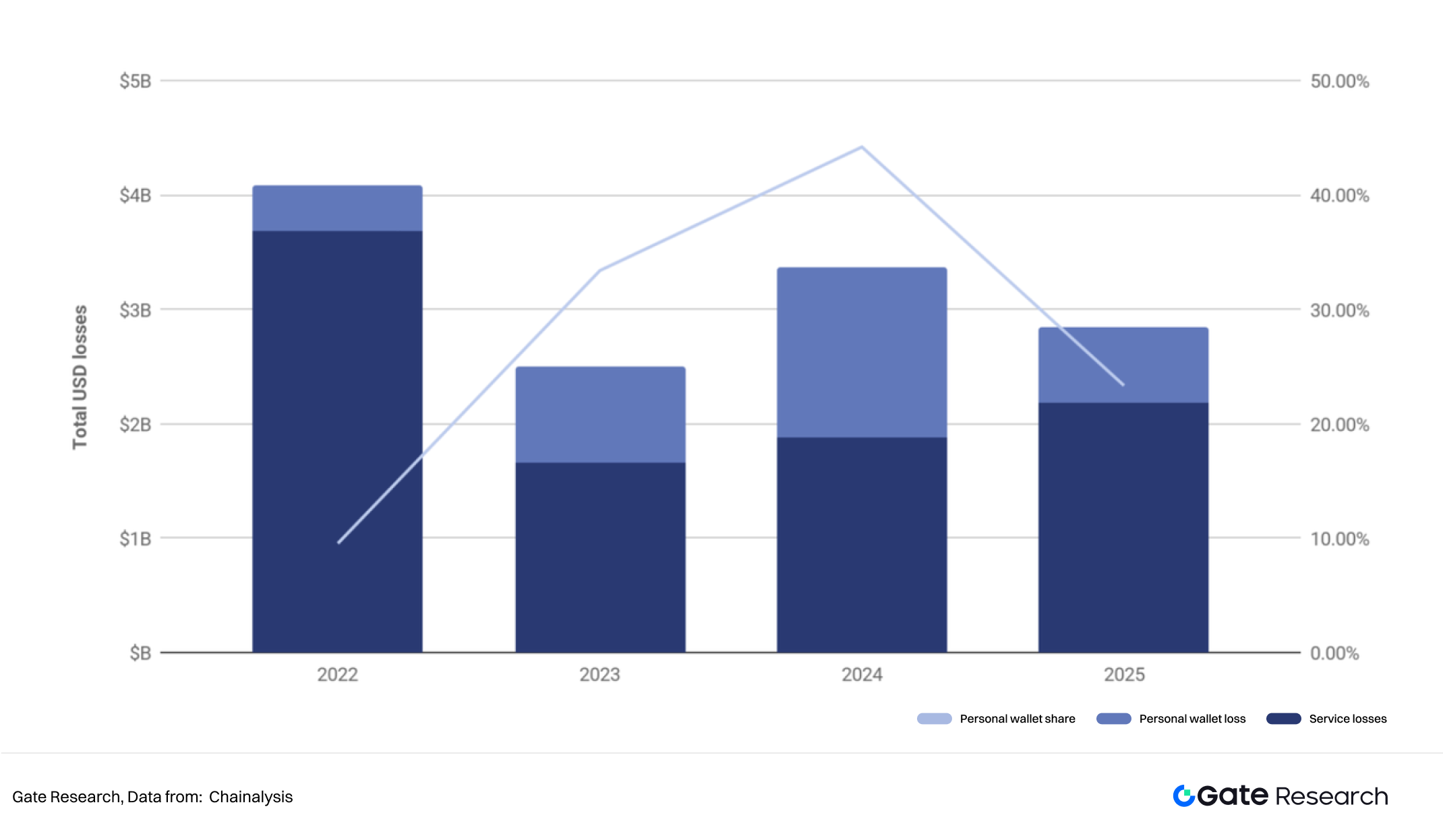
Historical data shows that DeFi platforms have long been primary targets for hackers, as developers focus more on rapid product launches than on security measures. However, in recent years, the focus of hacker attacks has gradually shifted to centralized services, with typical cases including the theft of $305 million in Bitcoin from DMM in 2024 and $234.9 million from WazirX. Notably, private key leaks account for the highest proportion of stolen crypto assets, reaching 43.8%, highlighting the reliance of centralized services on private key security. Since centralized exchanges manage a large amount of user funds, improper private key management can lead not only to catastrophic losses but also to reputational risks that affect client trust. The DMM case exemplifies the importance of strengthening private key protection and overall security mechanisms.
Additionally, mainstream crypto platforms typically rely on third-party or internal custody systems for their wealth management operations, such as Fireblocks, Ceffu, and BitGo. While these can provide security mechanisms like multi-signature, MPC, or cold wallets to ensure asset safety, they may still have systemic risks due to software vulnerabilities or centralized management.
For DeFi products or structured products, conducting third-party security audits and continuously implementing bug bounty programs are important means to reduce technological risks. At the same time, wealth management institutions should establish comprehensive emergency response mechanisms and insurance protections to minimize potential losses.
5.3 Market Volatility Risks
The high volatility of the cryptocurrency market is a significant market risk faced by wealth management institutions. Specifically, in extreme market conditions, the daily price fluctuations of BTC and ETH can reach ±10%, and even structured financial products, such as dual currency products, may incur principal losses. Although overall volatility has decreased in recent years with the introduction of tools like spot ETFs, seasonal fluctuations and event-driven severe market conditions still occur. For example, in October 2025, the crypto market experienced the largest liquidation event in history, indicating that macro events, regulatory changes, or significant on-chain events can still trigger severe volatility, directly affecting net value exposure, margin requirements, and liquidity, putting pressure on clients' risk tolerance and investment psychology.
This high volatility not only increases the difficulty of portfolio management but also raises higher demands on risk control, liquidity arrangements, and capital preparation for wealth management institutions. To address volatility risks, institutions should adopt diversified investment strategies, allocating different crypto assets, stablecoins, and traditional assets to reduce the impact of a single asset on the portfolio. Additionally, by setting stop-loss orders, risk limits, and employing dynamic asset allocation and quantitative risk models to respond to market emergencies, they can better manage risks. Furthermore, combining scenario simulations and stress tests to assess the potential impact of extreme market conditions on the portfolio can enhance the scientific nature of risk warnings and decision-making, thereby more robustly protecting client assets in volatile markets.
5.4 Liquidity Risk
In addition to market volatility, crypto wealth institutions also face a significant liquidity issue. Liquidity risk refers to the risk of assets being difficult to liquidate in a timely manner when market demand is insufficient or trading is restricted. In the crypto market, niche tokens or projects with low trading volumes in secondary markets are particularly prominent, which may prevent clients from quickly liquidating their assets when funds are needed or force them to sell at a discount. For example, certain DeFi tokens may lack sufficient trading depth during market downturns, making it difficult for investors to exit quickly, thereby increasing losses.
Historical cases show that the algorithmic stablecoin UST's de-pegging crisis in 2022 led to the depletion of on-chain liquidity pools, further impacting the entire DeFi market. At the same time, liquidity risk exists not only in decentralized markets but also troubles centralized platforms. The collapse of FTX exposed typical centralized liquidity mismatches and run risks; when users concentrated their withdrawals, the platform lacked sufficient reserves, ultimately leading to systemic collapse.
Similarly, during severe market sell-offs or extreme volatility, lenders and market makers often choose to withdraw funds, resulting in a sharp decline in trading depth and significant price slippage, amplifying short-term liquidity risks. Although data shows that DeFi's Total Value Locked (TVL) reached approximately $237 billion in the third quarter of 2025, indicating long-term liquidity improvements, the market's vulnerability remains evident during sudden events.
Therefore, strategies to address liquidity risk should include prioritizing the allocation of high-liquidity assets, setting reasonable position ratios, and utilizing derivatives or lending tools for dynamic liquidity management when necessary. Additionally, a liquidity monitoring and early warning mechanism should be established to ensure assets can be timely allocated in different market environments. For large redemptions or trades, a phased execution strategy can be employed, liquidity support agreements can be signed with core market makers, and short-term financing channels can be reserved to enhance the ability to respond to sudden liquidity shocks.
6. Industry Development Trend Forecast
6.1 Development Direction
As the global crypto asset market continues to mature, the number of high-net-worth users is steadily increasing, leading to a rapid growth trend in the demand for crypto asset wealth management. More and more investors with millions of dollars are beginning to seek professional and customized asset allocation solutions to preserve wealth and achieve steady growth in a highly volatile market.
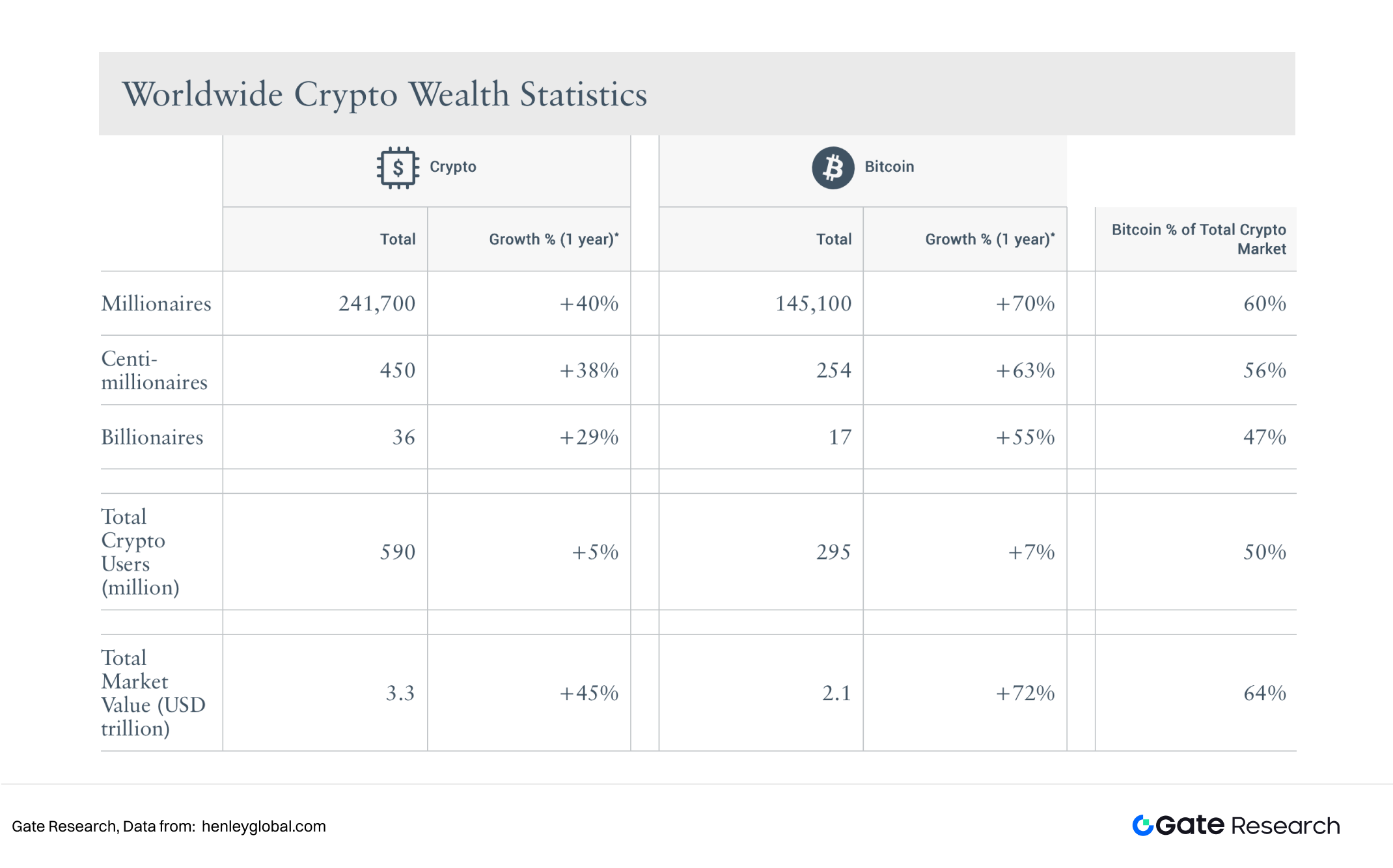
In this context, crypto private wealth management is at a critical transition from the "exploration stage" to the "systematic construction stage." In the coming years, with the acceleration of institutional compliance processes, the upgrading of investor structures, and the deep integration of traditional finance and crypto finance, the industry is expected to present a more professional, compliant, and diversified landscape.
6.1.1 Cross-Border Integration and Institutionalization Accelerate as the Main Line
Crypto private wealth management will no longer be an isolated track but rather a fusion ecosystem involving traditional financial institutions, family offices, and crypto-native platforms. A survey conducted in 2025 indicated that the vast majority of institutions currently have a risk exposure of less than 5% in crypto assets, suggesting that institutions are still in the early exploratory stage. However, as regulatory transparency increases and compliance custody and liquidity infrastructure improve, this proportion is expected to rise significantly in the next three years, with traditional financial capital flowing more extensively into the crypto asset category. By then, banks, brokerages, and asset management companies are expected to successively launch crypto wealth management, custody, and structured investment products, forming cooperative or competitive relationships with native exchanges and DeFi protocols to build a multi-layered wealth management system.
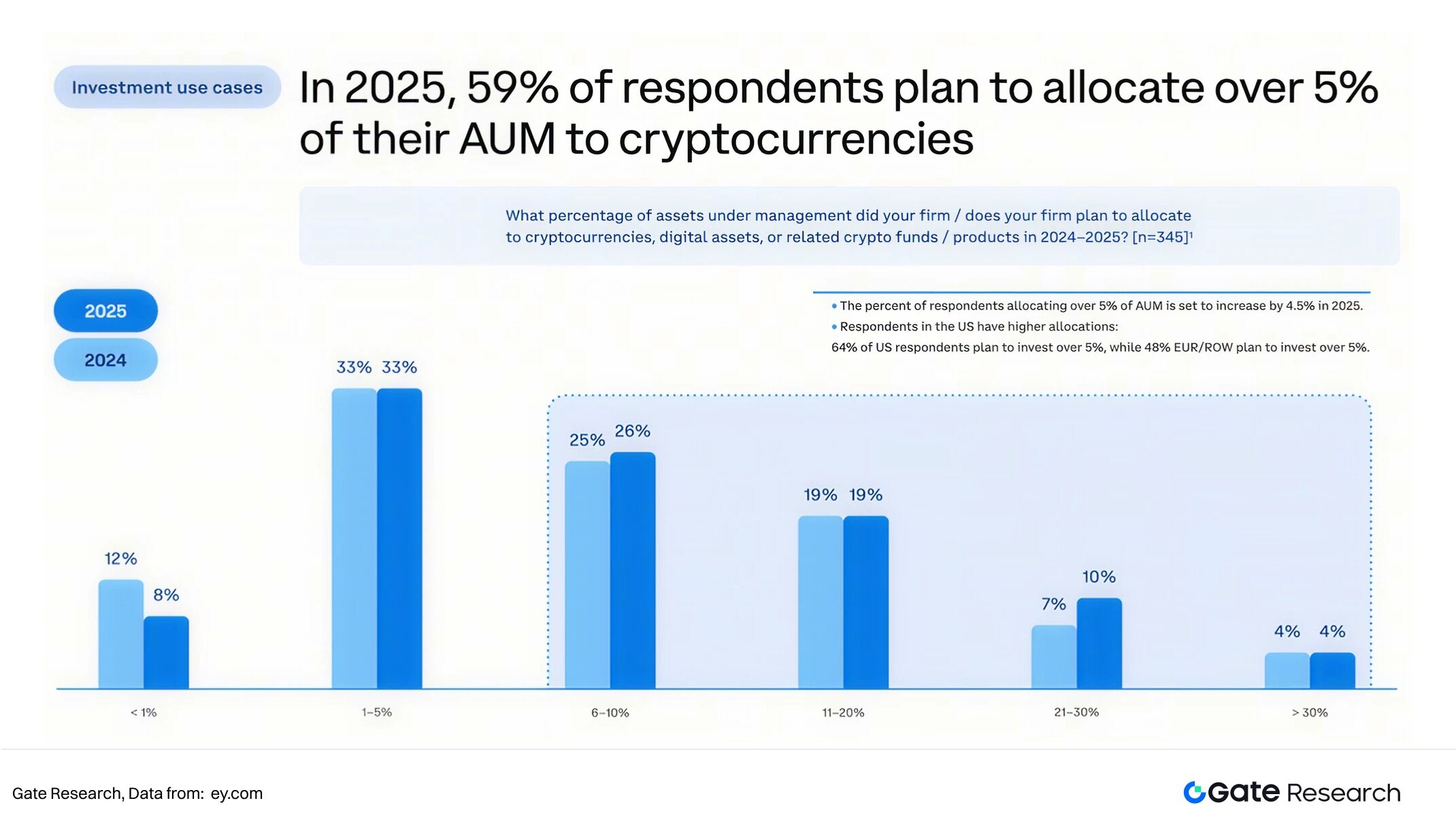
The client base will also diversify accordingly: on one hand, the allocation demand from traditional high-net-worth and institutional clients continues to grow, as they prefer to access crypto assets through compliant channels; on the other hand, native crypto investors are gradually seeking more systematic asset management and tax planning services, pushing the service model from "product-oriented" to "advisor-oriented." Future crypto private wealth institutions will place greater emphasis on building investment advisory and research support capabilities, providing a multilingual, cross-market customer service system. Meanwhile, AI and big data analytics will be deeply embedded in portfolio optimization, risk control, and client profiling to enhance customized services and strategy precision, achieving truly data-driven wealth management.
6.1.2 Product Structure Evolves from Single Investment to Multi-Layered Allocation
In the past, crypto wealth management primarily focused on single models such as "high-yield wealth management" or "single-token staking." Although the returns were significant, there was relatively insufficient risk layering, asset allocation, and strategy diversity. As the market matures and institutional participation increases, crypto wealth products are expected to evolve towards multi-layered, composite allocations in the next three years, forming a more robust and structured investment system.
First, at the product level, the allocation structure will trend towards diversification, for example:
FOFs (Fund of Funds): Achieving yield optimization and risk diversification through a combination of various crypto funds, DeFi protocols, stablecoins, NFTs, and other asset classes via quantitative, trend-following, and event-driven strategies;
Mixed Allocation of Digital and Traditional Assets: The tokenization of real-world assets (RWA) will further reshape the yield foundation of crypto wealth. The tokenization of bonds, gold, treasury bills, and other assets not only constructs cross-asset yield sources but also enhances the overall stability of the portfolio;
Hybrid Structure of CeFi + DeFi: CeFi platforms provide robust custody and basic yields due to their compliance and risk control advantages, while DeFi protocols inject high-yield on-chain strategies, balancing security and flexibility;
AI-Driven: By analyzing volatility, on-chain capital flows, and market behavior in real-time, AI can automatically optimize investment portfolios and risk exposures, transitioning wealth management from "experience-based decision-making" to "data-driven."
This trend indicates that crypto wealth management is shifting from a singular focus on "pursuing returns" to "risk control + portfolio management," increasingly aligning with the family office model in traditional finance.
6.1.3 Compliance and Global Layout
The gradual clarification of the global regulatory landscape is the most certain change in the crypto wealth management industry over the next three years—some countries and regions have begun to open crypto asset exchanges, ETFs, custody services, and the implementation of anti-money laundering standards. Regulatory clarity not only enhances high-net-worth clients' trust in crypto asset allocation but also provides wealth management institutions with institutional space for product innovation and risk management. In the next three years, institutions with global custody, cross-border compliance, and multi-currency service capabilities will become core market players, forming a compliant competitive landscape of "licensed operations + multi-asset allocation."
6.2 Future Market Size Forecast
6.2.1 Methods and Assumptions
This article defines the "market size of crypto private wealth management" as the total amount of client investable assets (AUM) managed by institutions that specialize in providing crypto asset custody, portfolio management, structured products, and customized wealth management services.
Due to data dispersion, the "anchor-penetration" modeling method is used here: taking the current on-chain/ETP/high-net-worth holdings as an anchor point, it is assumed that private wealth management can gradually absorb a portion of these as manageable AUM, dynamically adjusting the penetration rate in conjunction with the speed of institutional and regulatory maturity.
Main parameter examples: taking on-chain AUM + ETP substitutable shares + estimated crypto asset holdings of high-net-worth individuals.
On-chain and Crypto Asset Management AUM: The AUM of on-chain asset management is expected to surge to approximately $35 billion by 2025 (mainly composed of automated yield vaults, structured, and active strategies), representing a year-on-year growth of 118%; the market expects this figure to double in 2026.
Crypto-Related Exchange-Traded Products (ETP): ETPs experienced explosive growth in 2024, with AUM reaching $134.5 billion in November 2024, a year-on-year increase of 950%; as of October 18, 2025, AUM was $220.7 billion, a year-on-year increase of 64%.
High-Net-Worth Holdings: As of June 2025, the global holdings of crypto assets by high-net-worth individuals exceeded $242.5 billion, a year-on-year increase of 40%.
Therefore, it can be estimated that the total AUM of crypto assets currently manageable by professionals is $498.2 billion.
Although some exchanges, private banks, and family offices have begun to offer custody and strategy products, considering that a large amount of on-chain assets, ETFs, and high-net-worth holdings are still managed by native platforms, exchanges, fund managers, or self-managed rather than through private wealth management channels. According to Caia data, traditional private wealth accounts for about 16% of alternatives, and considering the shares of private banks, high-net-worth clients, and family offices, it is estimated that private wealth in traditional finance accounts for about 20-30% of total wealth management. As mentioned earlier, according to industry research, the productization and custody penetration of crypto private wealth are still in the early stages, with crypto assets having less than 5% of AUM allocated. Therefore, it is reasonably estimated that the current coverage rate of the crypto private wealth management market is 3-5%.
The current private wealth management scale is estimated to be ($498.2 * 3% = $149.46; $498.2 * 5% = $249.1), or $14.9 billion to $24.9 billion.
6.2.2 Scenario Forecast and Estimation
Forecast period: Starting from the end of 2025, predicting three years ahead (i.e., the end of 2028).
Assuming that regulations gradually clarify, institutions and banks gradually provide compliant custody and wealth management products, and the industry rapidly productizes but does not achieve full penetration; assuming that on-chain AUM maintains a growth rate of 118%, ETP AUM maintains a growth rate of 64%, and high-net-worth holdings maintain a growth rate of 40%; assuming that the current penetration rate of private wealth is 3%, it will rise to 6% in three years.
Neutral Scenario: In this context, the AUM of crypto assets that can be professionally managed for high-net-worth individuals is estimated to be $2 trillion, with the market size of crypto private wealth management around $120 billion, representing a 4.8-8 times increase from the current level.
Optimistic Scenario: If major jurisdictions globally complete key regulatory frameworks within 1-2 years, and traditional private banks and family offices significantly enter the market, the penetration rate may further increase to around 8%. In this context, the AUM of crypto assets that can be professionally managed may grow 5-8 times within three years, thereby increasing the market size of crypto private wealth management to $200-320 billion.
In the next three years, the core opportunities in crypto private wealth management lie in institutionalization, compliance, diversified products, and global layout. By integrating traditional finance and crypto ecosystem resources, constructing an advisor-driven multi-layered investment system, and leveraging AI and big data technologies to optimize portfolios and risk management, crypto institutions are expected to gain a competitive advantage in the rapidly expanding market.
7. Conclusion
The emergence of cryptocurrencies not only provides wealth managers with new market opportunities but also drives innovation in wealth management methods—the traditional "human + bank" model is being supplemented by on-chain digital assets. With the growth of global wealth and the expansion of high-net-worth populations, the development momentum of the crypto wealth industry is increasingly robust.
The product system of crypto private wealth management not only covers traditional wealth management categories such as "basic custody, yield management, structured investment, and family governance" but also centers on "on-chain verifiability, asset digitization, and client asset sovereignty," achieving yield diversification, controllable risks, and efficient cross-border services.
As regulations, technologies, and service standards gradually improve, crypto private wealth is rapidly evolving from the exploration stage to a systematic and institutionalized phase. "Hybrid structures of CeFi and DeFi, RWA tokenization, and AI-driven intelligent advisory" will become the core themes of industry development.
In the future, innovations driven by digitalization and on-chain technologies will continue to enhance the participation of high-net-worth clients and the efficiency of wealth management. It is expected that by 2028, the market size of crypto private wealth management could reach between $120 billion and $320 billion, achieving a dual trend of rapid growth and gradual industry maturity.
References
•Gate, https://www.gate.com/private-wealth
•UBS, https://www.ubs.com/us/en/wealth-management/insights/global-wealth-report.html
•CFA Institute, https://www.cfainstitute.org/insights/professional-learning/refresher-readings/2025/overview-private-wealth-management
•Morgan Stanley, https://www.morganstanley.com/what-we-do/wealth-management/private-wealth-management
•Goldman, https://privatewealth.goldmansachs.com/us/en/home
•Morgan Stanley, https://www.morganstanley.com/about-us-ir/shareholder/2q2025.pdf
•Morgan Stanley, https://advisor.morganstanley.com/zach.winning/documents/field/z/za/zachary-winning/MSPS_Pitchbook.pdf
•Morgan Stanley, https://www.morganstanley.com.au/content/dam/msaustralia/others/multi-asset-portfolio-solutions/230220/MAPS-CoreConservativeMonthlyReport_20230220.pdf
•GlobeNewswire, https://www.globenewswire.com/news-release/2025/09/23/3154424/0/en/World-Nears-Quarter-Million-Crypto-Millionaires-in-Historic-Wealth-Boom.html
•Cointelegraph, https://cointelegraph.com/news/defi-tvl-record-237b-dapp-wallets-drop-22-q3-2025
•Flow Traders, https://flowtraders.com/media/i33f1ipp/crypto-etp-report.pdf
•Chainalysis, https://www.chainalysis.com/blog/2025-crypto-crime-mid-year-update/
•Caia, https://caia.org/blog/2025/01/13/young-money-quantifying-private-wealth-management-opportunity
Gate Research Institute is a comprehensive blockchain and cryptocurrency research platform that provides readers with in-depth content, including technical analysis, hot insights, market reviews, industry research, trend forecasts, and macroeconomic policy analysis.
Disclaimer
Investing in the cryptocurrency market involves high risks. Users are advised to conduct independent research and fully understand the nature of the assets and products they purchase before making any investment decisions. Gate is not responsible for any losses or damages resulting from such investment decisions.
免责声明:本文章仅代表作者个人观点,不代表本平台的立场和观点。本文章仅供信息分享,不构成对任何人的任何投资建议。用户与作者之间的任何争议,与本平台无关。如网页中刊载的文章或图片涉及侵权,请提供相关的权利证明和身份证明发送邮件到support@aicoin.com,本平台相关工作人员将会进行核查。



